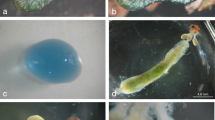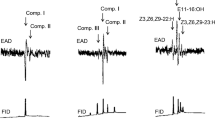Abstract
Eggs of several insect species are protected against natural enemies by noxious components. However, almost nothing is known about the fate of these defensive substances during egg development nor their site of biosynthesis. The eggs of several leaf beetle species of the taxon Galerucini contain components that are unusual in insects: 1,8-dihydroxylated anthraquinones and anthrones that deter predators such as ants and birds. These components, i.e., the anthrones dithranol and chrysarobin, and the anthraquinones chrysazin and chrysophanol, are not sequestered from host plants. We asked whether the amounts of these components in the overwintering eggs of Galeruca tanaceti change from deposition to larval hatching. Gas chromatography-mass spectroscopy (GC-MS) analyses of eggs revealed a significant decrease in total amounts of dithranol and chrysophanol from egg deposition in autumn to the next spring 5 months later. Thus, these results do not provide any hint of active anthraquinone biosynthesis within eggs. Instead, the anthrones and anthraquinones that must be incorporated by the female into the eggs seem to be degraded to some extent either by the embryo or endosymbionts. GC-MS analyses showed that parasitization of eggs had some effects on the quantities of anthrones and anthraquinones.
Similar content being viewed by others
References
Blum, M. S. and Hilker, M. 2002. Chemical protection of insect eggs, pp. 61–90, in M. Hilker and T. Meiners (eds.). Chemoecology of Insect Eggs and Egg Deposition. Blackwell Publishing, Berlin.
Derksen, G. C. H., Naayer, M., Van Beek, T. A., Capelle, A., Haaksman, I. K., Van Doren, H. A., and De Groot, Æ. 2003. Chemical and enzymatic hydrolysis of anthraquinone glycosides from madder roots. Phytochem. Anal. 14:137–144.
Gorman, M. J., Kankanala, P., and Kanost, M. R. 2004. Bacterial challenge stimulates innate immune responses in extra-embryonic tissues of tobacco hornworm eggs. Insect Mol. Biol. 13:19–24.
Hernández-Hernández, F. C., García-Gil De Muñoz, F., Rojas-Martínez, A., Hernández-Martínez, S., and Lanz-Mendoza, H. 2003. Caraminic acid dye from the homopteran Dactylopius coccus hemolymph is consumed during treatment with different microbial elicitors. Arch. Insect Biochem. 54:37–45.
Hilker, M. and Schulz, S. 1991. Anthraquinones in different developmental stages of Galeruca tanaceti (Coleoptera, Chrysomelidae). J. Chem. Ecol. 17:2323–2332.
Hilker, M., Eschbach, U., and Dettner, K. 1992. Occurrence of anthraquinones in eggs and larvae of several Galerucinae (Coleoptera: Chrysomelidae). Naturwissenschaften 79:271–274.
Meiners, T., Köpf, A., Stein, C., and Hilker, M. 1997. Chemical signals mediating interactions between Galeruca tanaceti L. (Coleoptera, Chrysomelidae) and its egg parasitoid Oomyzus galerucivorus (Hedqvits) (Hymenoptera, Eulophidae). J. Insect Behav. 10:523–539.
Obermaier, E., Heisswolf, A., Randlkofer, B., and Meiners, T. 2006. Enemies in low places—Insects avoid winter mortality and egg parasitism by modulating oviposition height. Bull. Entomol. Res. (in press)
Teuscher, E. and Lindequist, U. 1994. Biogene Gifte. Fischer Verlag, Stuttgart.
Wang, H. S. and Kang, L. 2005. Effects of cooling rates on the cold hardiness and cryoprotectant profiles of locust eggs. Cryobiology 51:220–229.
Acknowledgments
We are grateful to Frank Müller for support with the GC-MS analyses. We also thank Barbara Randlkofer, Freie Universität Berlin, Germany, and Ina Heidinger, University Wuerzburg, Germany, for help with egg mass collections. This study was supported by a grant of the Deutsche Forschungsgemeinschaft Hi 416/16-1,2.
Author information
Authors and Affiliations
Corresponding author
Rights and permissions
About this article
Cite this article
Pankewitz, F., Hilker, M. Defensive Components in Insect Eggs: Are Anthraquinones Produced during Egg Development?. J Chem Ecol 32, 2067–2072 (2006). https://doi.org/10.1007/s10886-006-9129-5
Received:
Revised:
Accepted:
Published:
Issue Date:
DOI: https://doi.org/10.1007/s10886-006-9129-5




